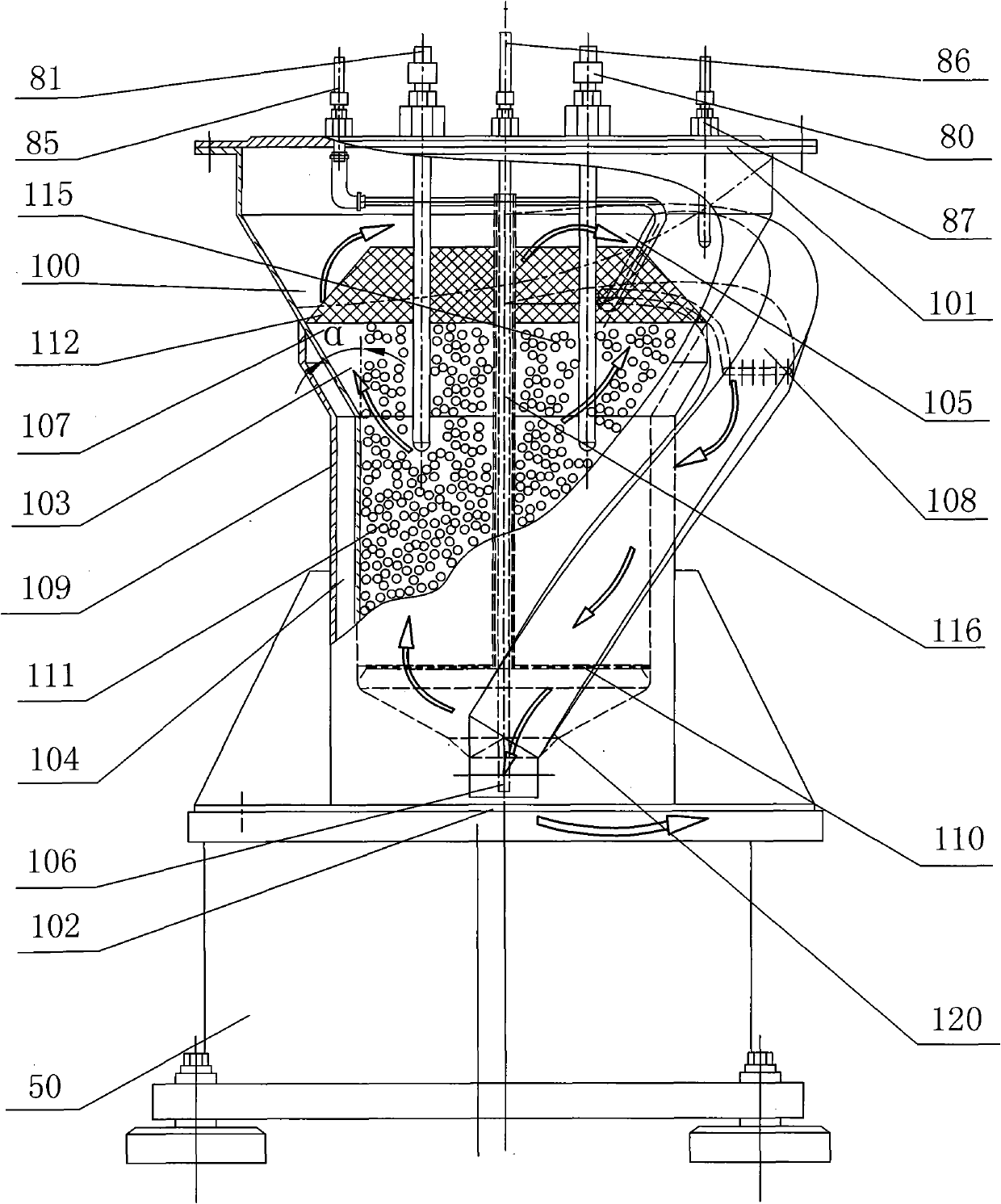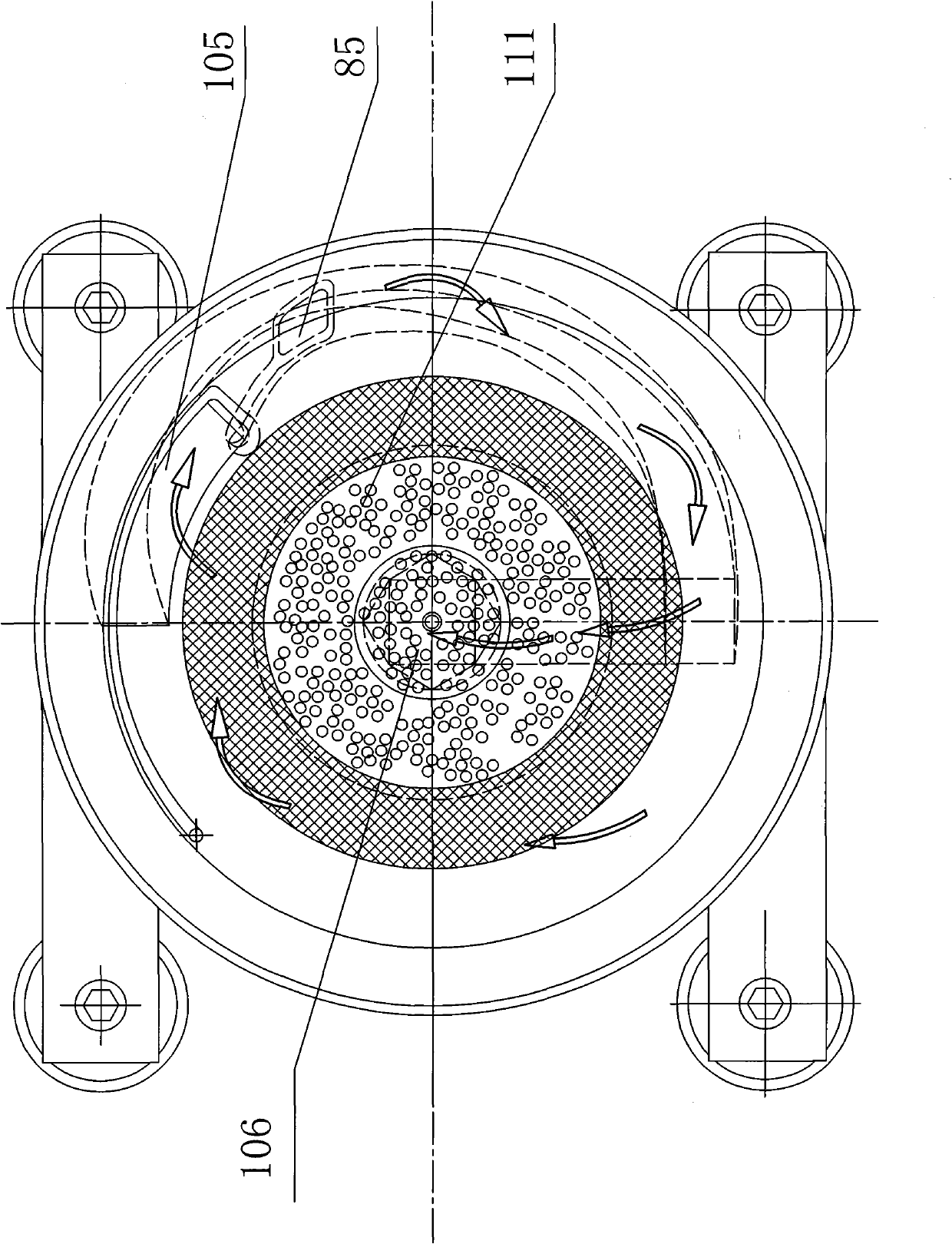Fluidized bed type cell reactor circulating outside tank and method for cultivating animal cells
A technology of cell reactors and animal cells, applied in tissue cell/virus culture devices, biochemical equipment and methods, biochemical instruments, etc., can solve problems such as low dissolved oxygen level, microbial contamination, cell death, etc., and achieve dissolved oxygen Fast speed, high degree of imitation of life, and the effect of reducing the probability of pollution
- Summary
- Abstract
- Description
- Claims
- Application Information
AI Technical Summary
Problems solved by technology
Method used
Image
Examples
Embodiment 1
[0020] The fluidized bed cell reactor with external circulation of the tank comprises: a reaction tank body 100, the bottom of which is connected to a shaking table 50, and the shaking of the shaking table makes the reaction tank body rotate eccentrically. The upper part of the reaction tank body 100 is in the shape of a truncated cone 107, the lower part is in the shape of a cylinder 109, and the bottom is in the shape of a cone 120. The upper part of the truncated cone is equipped with an outer conduit 108, and the entrance of the outer conduit is opened on the On the inner wall of the conical part of the reaction tank, the outer conduit is unscrewed around the tank body outside the tank, and the outer conduit is wound around the tank body 180 outside the tank 0 , the liquid return port 106 at the outlet end of the outer conduit enters the reaction tank body from the center of the bottom of the tank body, the tank body of the reaction tank has a tank cover with an inlet pipe ...
Embodiment 2
[0022] The fluidized bed cell reactor of embodiment 1, which belongs to the external circulation of the tank, has a microporous plate 110, an empty casing 116 and a macroporous microcarrier 111 in the described cell survival area, and the inner cylindrical shape of the reaction tank body 100 is 109 The inner wall and the frustum-shaped 107 inner wall are connected to the upper conical filter screen, and the lower end is connected to the microporous plate 110. The microporous plate 110 is connected to the empty sleeve 116 to form a cell survival area, and the cell survival area is connected to the center line of the reaction tank body. Concentric, the conical 120 lower end of the bottom of the reaction tank is connected to the liquid return port 116 at the end of the outer conduit, so that the communication with the outer conduit is realized at the bottom of the tank; the reaction tank body 100 has a chassis 102, the reaction tank 100 and the shaking plate 50 are connected throu...
Embodiment 3
[0024] The fluidized-bed cell reactor of embodiment 1 or 2 described in the external circulation of the tank, the semi-vertical angle α of the surface of the upper frustum of the tank body of the reaction tank is 25° to 55°, such as 30° or 35° , 40°, 45° or 50°, which can be determined through experiments according to the dissolved oxygen level of the required nutrient solution and the required circulation speed. Generally, it is better between 30-42°. The outside of the reaction tank Thermal insulation water jacket 104 is arranged.
[0025] The fluidized bed cell reactor with external circulation of the tank, the tank body of the reaction tank and the shaker are fixed with bolts; the tank body and the upper cover are sealed with an "O" rubber ring The cylindrical shape of the lower part of the reaction tank body has rounded corners and transitions to the bottom conical shape, and the bottom of the inner side of the reaction tank body has a conical shape. end.
PUM
 Login to View More
Login to View More Abstract
Description
Claims
Application Information
 Login to View More
Login to View More - R&D
- Intellectual Property
- Life Sciences
- Materials
- Tech Scout
- Unparalleled Data Quality
- Higher Quality Content
- 60% Fewer Hallucinations
Browse by: Latest US Patents, China's latest patents, Technical Efficacy Thesaurus, Application Domain, Technology Topic, Popular Technical Reports.
© 2025 PatSnap. All rights reserved.Legal|Privacy policy|Modern Slavery Act Transparency Statement|Sitemap|About US| Contact US: help@patsnap.com



